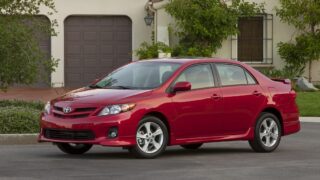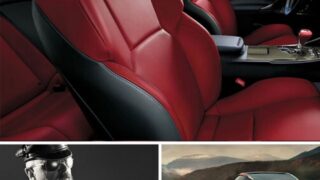On the Road With the 2011 Lexus CT200h
Toyota/Lexus has perfected the modern gas-electric hybrid perhaps more than any other manufacturer. Though it trailed the original Honda Insight to market by some nine months, the Prius clearly brought the gas-electric hybrid into the automotive mainstream more than the smaller, less-versatile Insight ever could have.

However, primarily because of the recent unrest and violence in several Middle-Eastern countries, the overthrow of the Mubarak regime in Egypt, and the uncertain future of the Gadaffi regime in Libya, oil-price speculators have bid up the world price of crude-oil (and gas-prices at the pumps) to levels not seen since the summer of 2008. So, it is not surprising that hybrids, among other alternate-fuel vehicles (diesels, plug-in electrics, E85 ethanol, etc…..) are currently quite popular (premium gas reached over $4 in my neighborhood just a couple of days ago). While I’m not going to go into the politics of the current high oil-prices too much (that, again, is not the purpose of the review), I think it is worth pointing out that, despite the unrest in the Middle East and its uncertain future, there is still no REAL gas shortage (estimates are a 1-2% disruption in world-supply at most), so the bid-up in oil prices seems to be purely speculative and/or panic-based, based on the simple ANTICIPATION of a shortage, not a real one as yet.

OK…we’ll leave the rest of that issue for the pundits. Lets’s get back to hybrids. As aforementioned, Toyota and Lexus have an impressive history of marketing and selling hybrids in the U.S., and the CT200 is simply the latest of a long line. It follows the U.S. introduction of the slightly larger, 4-cylinder hybrid HS250h sedan, which is based on the Toyota Avensis, a sedan not sold in the U.S. The HS, though, was never offered as a hatchback/wagon, and that void is (perhaps) now filled by the all-new CT, though the CT is a noticeably smaller car than the HS.
Two models of the CT200h are offered in the American market; a base model at $29,120, and a Premium at $30,900….the lowest prices for any Lexus model offered in the U.S. NAV packages, and a few other options, are offered separately. Both lines come with a CVT (Continuously-Variable-Transmission) and the 1.8L four/electric motor combinaton. The Lexus shop I was at had three in stock today…a beautiful Matador Red base model (the Matador Red is a remarkable color), a Mustard-colored (Daybreak Yellow) Premium model in the showroom, and an Obsidian (Black) Premium model as a demo, out on the ramp. I wanted to test-drive the red base model, but, as I was looking it over, a salesman came out with a middle-aged couple who was interested in it, so, that was that…..I took the black one out on the road instead. In fact, I don’t know how long the black one lasted after I left….the CT, because of high gas prices, is currently in high demand and short supply.

This was not the worst modern car (or the worst hybrid) I have driven by any means, but, to be honest, by Lexus standards, I was not terribly impressed with it. While I’ll save the details for later in the review, I wonder if the marketers might not have been smarter to sell this car as a Toyota instead of a Lexus.
Exterior:
As you first walk up to the CT200, its general body-shape is like that of a number of other small, Japanese-designed hatchbacks, particularly the current Mazda3, though it also bears a striking resemblance to my brother’s old 1995 Honda Civic CX Hatchback. The front-end has a more-or-less typical Lexus-sedan grille/headlights, so it’s not hard to tell as a member of the Lexus family there. The small size, though, is what impresses on you the most….Lexus has not, until now, sold a vehicle this small in the American market. That small size, despite the rather conservative, squarish roof line, does cut into some interior and cargo space……more on that below. The wide, concave-shaped C-Pillars hamper some of the rear-vision….also more on that below. So does the overly small (for a hatchback) rear-window and its minuscule, barely-6-inch wiper-blade, which looks like something off a toy car. The sheet metal on the fenders and doors is not the thinnest-feeling I’ve seen, but seems rather flimsy by Lexus standards. However, the doors and hatch-lid, despite the somewhat less-than-tank-grade sheet metal, still close with a firm, solid “thunk”…..a quality sound. There are no standard body-side moldings to help ward off parking-lot dings, and none I saw listed as accessories (for me, that would mean a trip to Advance Auto parts to get a stick-on aftermarket molding). The paint job, as usual for a Lexus product, is superb. Seven exterior paint colors are offered…I liked the Matador Red Mica, which is arguably the most impressive Lexus paint-job in the whole vehicle line-up (it will knock your socks off), the Daybreak Yellow Mica, which is not a bright Yellow but a mustard-yellow color, the always-classy White Pearl, and the increasingly popular Fire Agate Pearl, which is a rich, dark, chocolate-brown color. The ground clearance under the lower-body parts is quite low, which means being careful on speed-bumps/humps, ramps, and around road debris. The low-stance also hampers entry/exit a little for tall persons, though is is not as difficult to get in and out of as, say an extremely low-slung Miata or Corvette. A nice touch is the mirror-mounted turn-signal indicators, and the mirror-housings themselves are very well-done….shaped properly for good rear-vision, made of reasonably solid plastic, and buttery-smooth in their snap/swivel/lock operation. Most of the exterior trim is well-done and well-attached, except for the blue-and-chrome “Hybrid” badges on the lower-rear doors, which were still well-attached, but which, I though, looked tacky. The small, white Lexus decal on the upper-surface of the rear bumper (part of a cargo-area option) also, IMO, looked tacky. The blue-and-chrome “L” Lexus logos on the grille and deck-lid, though, looked nice, just as they do on other Lexus hybrid models. I was somewhat surprised by the 17″ 215/45, sport-oriented, low-profile tires, which seemed a little out of place on a small hybrid designed for economy, and they noticeably stiffened up the ride… more on that below.
Underhood:
Open up the somewhat lightweight-feeling, not very solid hood, and you are greeted with (yes, on a Lexus product here) a cheap manual prop-rod to hold it up instead of nice gas struts….although, to be fair, my old Lexus IS300 also had a prop-rod. The hood, however, does have a nice insulation-pad on the underside, helping to quiet the gas engine down a little. As to be expected with a small underhood space and a complex dual-engine hybrid drivetrain, things are rather tightly-fitted-in under the hood. The 1.8L Atkinson-cycle gas in-line four and permanent-magnet electric-drive motor fit in transversely, with the CVT transmission over on the right. A big plastic engine cover hides most of the top-components on the gas engine (the electric motor needs little or no maintenance), and there is little space to reach things down the sides of the block. Complex, hybrid and ABS-related computer hardware, plumbng, and wiring take up much of the rest of the space under hood, although the dipsticks, filler-caps, and reservoirs for the gas engine are generally accessible OK. Lexus, with some of its hybrids, has a peculiar habit of not listing, either on-line or on the official web-site, the HP/torque RPM peaks, or the separate HP/torque figures for each engine like other hybrid manufacturers do, only stating this system as “134 Total HP”…..so that’s what I will list. Years ago, I remember, Rolls-Royce, no matter how big or small the engine, used to officially list the power simply as “adequate”.
Interior:
The small interior was generally well-done and well-finished, and used, from what I could tell, far better materials inside than its cheaper Toyota Prius cousin. Its dash was also a lot easier to deal with than the geeky designs that the Prius has used over the years. That doesn’t mean that all of the controls, though, were, IMO, well-designed. I didn’t care for the chrome CVT-transmission-shift stub that jutted out of the dash. Nor did I care for the mouse-controller on the console that controls the NAV-system (a $2445 option). All of the buttons and controls, though, felt solid, well-attached, and were well-marked. The steering wheel was well-shaped, and the leather wrapping comfortable to hold. The NuLuxe seat upholstery, IMO, made the real-leather option unnecessary…it looked and felt far more like real leather than the less-pleasant MB-Tex and similar synthetic materials the German manufacturers use in their interiors. The NuLuxe is available in three colors, with the real leather in two. The standard dash/door-panel trim is silver brushed-metal, but Brown-Ash wood, Striped-Bamboo, and Striped-Graphite Metallic trim are available as factory-approved, dealer-installed accessories. Unfortunately, the Lexus dealer I was at today did not have any of the kits available…..they are still on order.
This is not a very comfortable interior, though, for larger-sized persons like me. It is just too small, especially by Lexus standards. Front headroom is OK, under the sunroof housing, if the seat-cushions are adjusted way down, but the rear-seat, even with the rather conservative square-back roofline, is best left for kids and maybe some small adults. (I forgot to check the sun-visor and head-lining material, but it is usually pretty nice in most Lexus products, without hard-feeling materials). The NuLuxe seat-material, as I described above, was a really nice substitute for leather, but the front seats themselves had cushion-bolsters that were just marginal for big torsos and rumps like mine…they pressed somewhat into the edges. The wide center console, with its numerous controls, was quite restrictive of my right leg when I was sitting in the drivers’ seat. The stereo sound, by Lexus standards, was a long way from the fabulous Mark Levinson unit in the LS460, and, to my ears, sounded a little flat (when you listen to KISS, AC/DC,and Heavy Metal, it’s nice to have the best). The stereo controls, typical of NAV units, were split between mechanical buttons/controls and the NAV screen….the climate-control buttons were mostly mechanical, but had a nice feel/solidness. The steering column was manually-adjustable for ilt/telescope, but had a rather limited range of adjustment. Non-NAV models (which I would probably choose for myself) had a small, useful, cubby-compartment in the center-console instead of the mouse-control. With the front seats adjusted rearward, the rear-seats would not fold down (or back up again) for added cargo space without taking off the headrests…..the headrests jammed against the back of the front seats. The headrests, with the rear seats up, also tended to block the edges of the rear-vision…..as did the big, wide C-pillars and small rear window, despite the high, conservative rear roof-line.
Cargo Area/Trunk:
Open the hatchback lid with a touch-sensitive pad under the hatch-lid (if the battery is low or not grounded properly, the pad may not work, as we found out with the mustard-yellow CT200 sitting in the showroom), and the lid flips up to reveal a rather small but generally well-shaped and well-finished cargo area. A decent grade of black carpeting covers the trunk floor. A built-in light makes it easier to see things in the dark. The total cargo space, though generally well-shaped because of the squarish roofline, is still on the small side….partially because of the hybrid-battery-pack location behind the rear seats, under the floor. The split-rear seats, of course, fold down to increase cargo space. My test car had the optional ($90) Subaru-type custom-fitted rubber cargo-bed cover for carpet protection, a $49 cargo-spider-net (don’t ask me how Lexus came up with that term), and a seemingly redundant Cargo Net/Cargo Mat/Wheel-locks package (as listed on the price-sticker) that looked to me like Lexus might (?) might be charging for the same options two or three different times. A removable pull-shade cover hides cargo-area items from prying eyes. Also under the floor is a split-compartment…..one part for the standard (and traditional) Lexus First-Aid Kit, and the other for the Owners’ Manual (which, of course, if desired, can also be kept in the glove-box). Under the split-compartment is (yep, you guessed it) a temporary spare tire and the jacking tools. The last Lexus I owned (a 2001 IS300) had a real spare tire/alloy wheel, not a cheap temporary one.
On the Road:
Start things up (as with most hybrids) with the engine POWER button, foot on the brake, and the electronic fob in the vicinity. The electrical system takes several seconds to respond, then the dash lights up, and you are greeted with….. more silence. Place the awkward-shifting (IMO) CVT dash-lever in R or D, and in the battery-charge state of my test-car (almost a full-charge), the car rolls quietly away, like a golf-cart, on the battery alone. The gas engine cuts in after a brief interval (you can hear it, but it is very quiet). There is a console-mounted knob marked ECO or SPORT…ECO highlights the hybrid-related battery-charge dash-gauges, while SPORT brings up a tachometer for the gas-engine (you can’t watch the engine-RPM in ECO, as the tach disappears). The rest of the gauges, including the speedometer, are generally clear and easy-to-read, but are mostly electronic-analog.
The drivetrain, upon staring up from rest, didn’t seem to be quite as smooth as that of the less-expensive Toyota Prius, or of other Lexus hybrids I’ve sampled. In my test-car at least, like the small Honda IMA hybrids with similar CVTs, you could feel a slight shuddering just as the CVT first engages on start-up….then it disappears after a second or so, and the system is then butter-smooth. The gas engine is almost as quiet as the electrics……you certainly aren’t going to wake the neighborhood up at 3 AM like you would with , say, a Mustang GT. You can barely hear it running with the quiet exhaust…….which, of course, is verified if you look at the tach in the SPORT mode. Like most parallel-type hybrids, the CT gets better mileage in the city where the gas engine runs less, but its 40 MPG highway mileage is now equaled by some conventional non-hybrid (and considerably less-expensive) cars like the Ford Fiesta and Hyundai Elantra. The CVT transmission is shifted solely with the lever…..there are no column-shift paddles or imitation-spaced CGT “gears” like with the Subaru and Nissan CVTs. This car, as you would expect, is no powerhouse…..as I stated earlier, Lexus rates it at only 134 HP with the gas and electric-motors combined, and the rather leisurely acceleration (Lexus quotes 9.8 seconds from 0-60), though IMO not unacceptable or unsafe, means that you will need to give yourself some room merging with faster-moving traffic.
The steering and chassis is definitely not what you would expect with a small hybrid, especially after driving something like a Prius or Insight. The 3rd-generation Prius is definitely sharper-handling than the second-generation model, but still not like the CT200. The CT (as I described above) uses 17″, 215-45 low-profile tires, which raise the tires’ rolling resistance (thence, only 40-43 MPG compared to the Prius’s 51 Highway), but add a lot of traction and steering response. The response is almost sports-car quick, even with the car’s front-end (FWD) weight-bias. But that, as expected, also stiffens up the ride….the CT, though not harsh, was quite noticeable over bumps, and it was afflicted with the almost constant bobbing, up/down porpoise-like motions that characterize some SUVs. This car, IMO, does not need handling this sharp (cornering is almost flat, with very little body lean), and the Lexus engineers would, IMO, be wise to loosen up a little on the spring/shock rates and use a little-higher-profile rubber next year…..say, a 50 or 55-series instead of 45. Road-noise, from the sport-oriented tires, was not obtrusive, but was a little more than you would expect from a Lexus product……same with wind noise.
I was very pleased with the brakes. The CT, like many hybrids, uses a regenerative-braking system that uses the drag and reverse-energy in the electric motor to not only help slow the car down, but to help recharge the battery-pack during the braking-mode. You could feel the added drag as the car slows, and the lessened-need to use the brake pedal itself. The flip side, of course, is that because of the added-drag from the regenerative braking, there is less of a braking feel in the pedal itself, and you can’t actually feel the amount of braking as much with your foot….the senses come in your brain, instead, as the car slows down. The brake pedal seems to be located OK for big feet….I don’t remember having any problems with my clown-size 15 shoes hanging up on the brake pedal going from gas to brake….but then, I didn’t use the pedal as much either as I do in a conventional car.
The Verdict:
Well, folks, I know that, despite the general auto-talk nature of CAR CHAT, CL this is generally a Lexus forum, and I don’t like to necessarily pan a Lexus product on its home-turf, but I have to be honest in my auto reviews. Given the design, size, and limitations of this car, I’m just not convinced that it should have been marketed as a Lexus product. It’s not a bad car per se, and, of course, it is well-built, and should turn out to have better-than-average reliability. True, it has the long Lexus 6/70 and 4/50 warranty and the well-known high level of Lexus customer service. But, to me, its ride, interior room, start-up drivetrain refinement, noise level, trim, stereo sound, and, of course, small overall size suggest to me that it would have been better-marketed as a Toyota instead of a Lexus. And, to cap it off, I’m not convinced that the car I drove was really worth its 36K price sticker, either, though base models without options can be had for around 31K out the door…..still, IMO, a rather stiff price for a car like this. And, with gas prices being what they are today, and the fact that small hybrids are current in high demand, don’t look for any bargain-basement deals from the salespeople, either. This car is likely to sell for list price, close to it, or maybe even a mark-up.
True, competing luxury-car companies have sometimes offered small 4-cylinder models like the Acura TSX/RSX, Infiniti G20, Mercedes C230 hatchback, BMW 318, Audi A3, etc…., but almost none of those cars were as small or as cramped inside as the CT200. In fact, I think that Lexus did a better overall job on its 4-cylinder HS than on the CT, and should, IMO, have simply considered a hatchback/wagon version of the HS before bringing out the all-new CT. But, of course, if you are not a large or portly adult and can fit in the small space, want a well-built small hybrid-hatchback with great gas mileage, want reliability and a high level of customer service, and don’t mind spending cash in the low-mid 30s for a car like this, then the CT might be just the car for you.
–mmarshall




